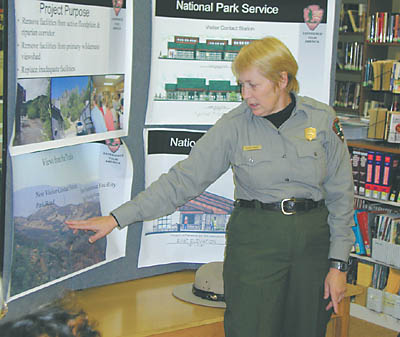
Pinnacles National Monument is in line to receive a facelift,
but one that officials hope visitors won’t find offensive to the
natural beauty of the park.
Pinnacles National Monument is in line to receive a facelift, but one that officials hope visitors won’t find offensive to the natural beauty of the park.
“You don’t want to see what man has done to the wilderness,” said state park ranger Karen Dennis, an environmental protection specialist. “We try to keep things as natural as if man has not involved himself.”
On Wednesday, Dennis told an audience at the San Juan Bautista Library that plans are moving forward to move the park’s main facilities across the road from its current location where a new 1,900-square-foot visitor center will replace the existing 600-square-foot building. Also, state officials hope to stay off the energy grid by using solar energy for electricity.
The project to relocate the center came about after the 1998 floods because the building is situated in an active floodplain and in a riparian zone.
“A lot of water came through the west side of the Pinnacles,” Dennis said. “It really was awful.”
The Pinnacles is about 70 percent wilderness, the state is mandated to protect the visual impacts of the area.
The project plans and environmental report were recently reviewed, but construction has been delayed for one year, Dennis said.
“We had hoped for 2004, but we were pushed back until October 2005,” she said. “(Then) we will be good to go.”
Congress began allocating funds for the project after the 1998 floods.
“But it will be another two years before we will get the funding for construction,” Dennis said.
Also, park officials are in the process of reintroducing California condors at the Pinnacles, which have not had a presence at the park since the 1970s. Officials plan the release for the east side of the campground sometime in September.
“We have anywhere from three to six birds in the flight pen,” Dennis said, adding that the condors were in captivity and have become familiar with humans.
She said one of the most challenging aspects of the condor project is to have access to the condors in the event of an emergency, which is why they are banded. Condors travel a radius of about 200 miles.
“They don’t have the grasp ability like an eagle or a hawk,” Dennis said. “They have no ability to catch food.”









